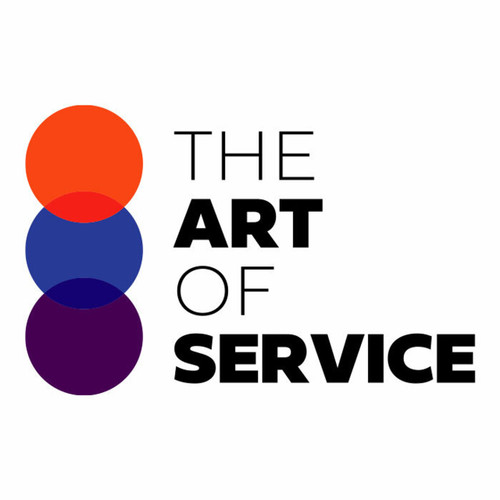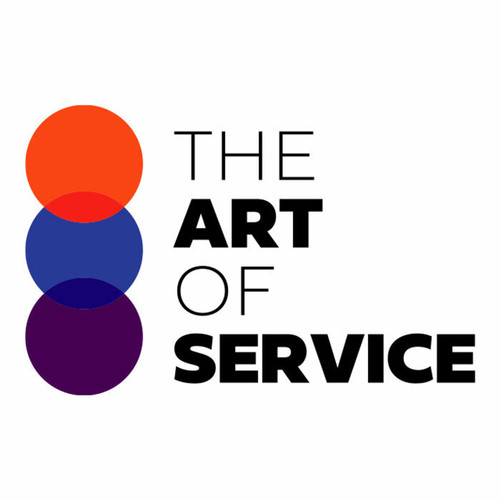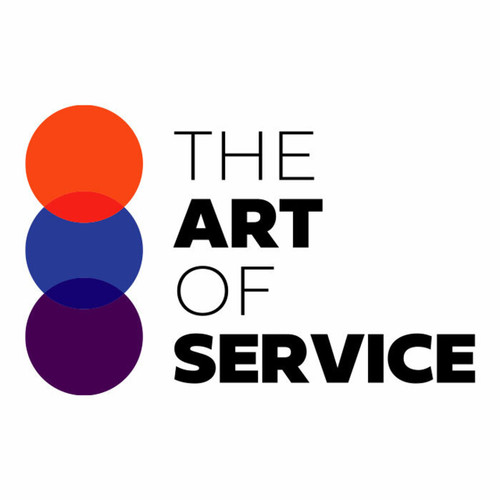Are you looking to achieve your business goals with a strategic and effective approach? Look no further.
We have the ultimate solution for you - our Stakeholder Management and Digital Transformation Playbook.
In today′s rapidly evolving digital landscape, it′s crucial to align your strategy, culture, and technology to succeed.
Our playbook is designed to provide you with the knowledge base that consists of the most important questions to ask to get results by urgency and scope.
With 1522 prioritized requirements, solutions, benefits, and results, our playbook is the go-to resource for any digital transformation project.
But what sets us apart from competitors and alternatives? Our Stakeholder Management and Digital Transformation Playbook is carefully curated for professionals like you, who want a comprehensive, easy-to-use, and affordable solution.
We have done extensive research to provide you with the best possible product that will help you achieve your business goals.
Our playbook is suitable for all businesses, whether you are a small startup or a large corporation.
It provides a detailed and in-depth overview of how to align your strategy, culture, and technology, making it the perfect investment for your business success.
Still not convinced? Our playbook also includes real-life case studies and use cases to showcase the effectiveness of our methodology.
You can see firsthand how our playbook has helped other businesses like yours reach their desired outcomes.
We understand that time and budget constraints can be a roadblock for businesses, but with our DIY/affordable product alternative, you can achieve your digital transformation goals without breaking the bank.
Our product details and specifications make it easy for you to understand and implement our playbook, regardless of your level of expertise.
Don′t let your business fall behind in this digital age.
Stay ahead of the curve with our Stakeholder Management and Digital Transformation Playbook.
With its countless benefits, such as improved efficiency, enhanced customer experience, increased revenue, and reduced costs, our playbook is a must-have for any business looking to succeed in today′s digital world.
So why wait? Invest in our Stakeholder Management and Digital Transformation Playbook today and see the results for yourself.
Create a winning strategy, foster a digital culture, and utilize the latest technology to achieve your business goals.
Order now and join the countless businesses that have already seen the benefits of our playbook.
Discover Insights, Make Informed Decisions, and Stay Ahead of the Curve:
Key Features:
Comprehensive set of 1522 prioritized Stakeholder Management requirements. - Extensive coverage of 146 Stakeholder Management topic scopes.
- In-depth analysis of 146 Stakeholder Management step-by-step solutions, benefits, BHAGs.
- Detailed examination of 146 Stakeholder Management case studies and use cases.
- Digital download upon purchase.
- Enjoy lifetime document updates included with your purchase.
- Benefit from a fully editable and customizable Excel format.
- Trusted and utilized by over 10,000 organizations.
- Covering: Secure Leadership Buy In, Ensure Scalability, Use Open Source, Implement Blockchain, Cloud Adoption, Communicate Vision, Finance Analytics, Stakeholder Management, Supply Chain Analytics, Ensure Cybersecurity, Customer Relationship Management, Use DevOps, Inventory Analytics, Ensure Customer Centricity, Data Migration, Optimize Infrastructure, Standards And Regulations, Data Destruction, Define Digital Strategy, KPIs And Metrics, Implement Cloud, HR Analytics, Implement RPA, Use AR VR, Facilities Management, Develop Employee Skills, Assess Current State, Innovation Labs, Promote Digital Inclusion, Data Integration, Cross Functional Collaboration, Business Case Development, Promote Digital Well Being, Implement APIs, Foster Collaboration, Identify Technology Gaps, Implement Governance, Leadership Support, Rapid Prototyping, Design Thinking, Establish Governance, Data Engineering, Improve Customer Experience, Change Management, API Integration, Mergers And Acquisitions, CRM Analytics, Create Roadmap, Implement Agile Methodologies, Ensure Data Privacy, Sales Enablement, Workforce Analytics, Business Continuity, Promote Innovation, Integrate Ecosystems, Leverage IoT, Bottom Up Approach, Digital Platforms, Top Down Approach, Disaster Recovery, Data Warehousing, Optimize Operations, Promote Agility, Facilities Analytics, Implement Analytics, Ensure Business Continuity, Quality Analytics, Dark Data, Develop Strategy, Cultural Considerations, Use AI, Supply Chain Digitization, Open Source, Promote Digital Education, Ensure Compliance, Robotic Process Automation, Logistics Automation, Data Operations, Partner Management, Ensure Sustainability, Predictive Maintenance, Data Lineage, Value Stream Mapping, Define Business Goals, Communication Plan, Use Digital Forensics, Startup Acquisitions, Use Big Data, Promote Cultural Sensitivity, Encourage Experimentation, Optimize Supply Chain, Smart Manufacturing, Manufacturing Analytics, Implement Digital Governance, Employee Engagement, Adopt Agile, Use Low Code, Test And Learn, Digitize Products, Compliance Analytics, AI Governance, Culture Of Innovation, Implement Smart Cities, Content Strategy, Implement Digital Marketing, Data Driven Decision Making, Mobile First, Establish Metrics, Data Governance, Data Lakes, Marketing Analytics, Risk Analytics, Patent Strategy, Data Science, Carbon Footprint, Technology Scouting, Embrace Mobile, Data Retention, Real Estate Analytics, Ensure Accessibility, Ensure Digital Trust, Automate Processes, Minimum Viable Product, Process Automation, Vendor Management, Implement Digital Workplace, IT Operations Analytics, Use Gamification, Ensure Transparency, Create Digital Twins, DevOps Practices, Adopt Microservices, Use No Code, Operations Analytics, Implement Smart Manufacturing, Social Media Strategy, IT Service Management, Brand Alignment, Use Chatbots, Service Design, Customer Journey, Implement Digital Platforms, Leverage Data, Sales Analytics, Promote Continuous Learning, Use Design Thinking
Stakeholder Management Assessment Dataset - Utilization, Solutions, Advantages, BHAG (Big Hairy Audacious Goal):
Stakeholder Management
Organizational philosophy sets the tone for stakeholder management by defining the organization′s values and approach to relationships, shaping behavior towards stakeholders and guiding decision-making to consider their interests.
1. Improved Communication: Clear communication of digital transformation goals to stakeholders.
2. Increased Collaboration: Encourages joint efforts towards digital transformation success.
3. Better Understanding: Increased awareness of stakeholders′ needs and expectations.
4. Risk Mitigation: Identifies and manages risks associated with digital transformation.
5. Enhanced Trust: Strengthens relationships through transparency and mutual understanding.
6. Shared Responsibility: Aligns stakeholders′ actions with the organization′s goals.
7. Informed Decisions: Provides stakeholders with the necessary information for decision-making.
8. Innovation: Fosters a culture of innovation through shared vision and collaboration.
9. Continuous Improvement: Encourages feedback and adaptation for better outcomes.
10. Long-Term Success: Builds a sustainable foundation for digital transformation and growth.
CONTROL QUESTION: How does the organizational philosophy establish a relationship between the organization and its stakeholders?
Big Hairy Audacious Goal (BHAG) for 10 years from now: A big hairy audacious goal (BHAG) for stakeholder management in 10 years could be for the organization to have achieved a state of Complete Stakeholder Symbiosis. This means that the organizational philosophy has evolved to the point where it has seamlessly integrated and aligned the interests of all stakeholders - including employees, customers, investors, partners, communities, and the environment - to work in harmony towards a shared vision and common goals.
To achieve Complete Stakeholder Symbiosis, the organization has implemented an effective and dynamic stakeholder engagement strategy that is grounded in the following principles:
1. Transparency and Openness: The organization operates with a high degree of transparency and openness, fostering trust and credibility with its stakeholders.
2. Collaboration and Co-creation: The organization collaborates and co-creates solutions with its stakeholders, leveraging diverse perspectives and expertise to achieve mutual benefits.
3. Empowerment and Participation: The organization empowers and enables its stakeholders to actively participate in decision-making and value creation processes.
4. Continuous Learning and Improvement: The organization engages in continuous learning and improvement, leveraging data, insights, and feedback from its stakeholders to enhance its relationships, products, and services.
5. Responsibility and Accountability: The organization takes responsibility and is accountable for its actions and impact, aligning its strategy and operations with social, ethical, and environmental principles.
Through these principles, the organization has established a strong and resilient culture of stakeholder management, built on the foundation of shared values and mutually beneficial relationships. As a result, the organization has not only achieved its strategic objectives and financial goals but has also made a positive impact on society and the environment, creating a sustainable and inclusive future for all.
Customer Testimonials:
"This dataset is a must-have for professionals seeking accurate and prioritized recommendations. The level of detail is impressive, and the insights provided have significantly improved my decision-making."
"Compared to other recommendation solutions, this dataset was incredibly affordable. The value I`ve received far outweighs the cost."
"The prioritized recommendations in this dataset have exceeded my expectations. It`s evident that the creators understand the needs of their users. I`ve already seen a positive impact on my results!"
Stakeholder Management Case Study/Use Case example - How to use:
Case Study: Stakeholder Management through Organizational PhilosophySynopsis of Client Situation
XYZ Company is a mid-sized manufacturing firm facing increasing pressure from both competitors and regulatory bodies. The company has a reputation for high-quality products but has struggled in recent years to maintain profitability and growth. The company′s leadership recognizes the need to build stronger relationships with stakeholders, including employees, customers, suppliers, and the broader community. However, the company lacks a clear organizational philosophy to guide its interactions with these groups.
Consulting Methodology
To address this challenge, XYZ Company engaged a consulting firm specializing in stakeholder management. The consulting process began with a thorough analysis of the company′s current situation, including a stakeholder mapping exercise to identify key stakeholders and their interests. The consulting team then facilitated a series of workshops with the company′s leadership to develop a clear organizational philosophy, grounded in the company′s values and mission.
The consulting team used a variety of tools and techniques to guide the development of the organizational philosophy, including:
* Appreciative inquiry: This approach focuses on identifying and building upon the company′s strengths and successes.
* Design thinking: This approach emphasizes empathy and co-creation, working closely with stakeholders to develop solutions that meet their needs.
* The Balanced Scorecard: This framework helps to align the organization′s philosophy with its strategic objectives and performance metrics.
Deliverables
The primary deliverable of the consulting engagement was a clearly articulated organizational philosophy, supported by a stakeholder engagement plan and a balanced scorecard framework. The organizational philosophy included the following elements:
* Mission statement: A clear and concise statement of the company′s purpose and goals.
* Values: A set of guiding principles that reflect the company′s beliefs and aspirations.
* Vision statement: A compelling picture of the company′s future state, based on its mission and values.
* Stakeholder expectations: A clear understanding of the needs and expectations of each stakeholder group, based on research and consultation.
* Stakeholder engagement strategies: A set of specific actions and tactics to build strong relationships with stakeholders, based on their interests and expectations.
Implementation Challenges
Implementing the organizational philosophy was not without challenges. The company′s leadership recognized the need for cultural change and committed to leading by example. However, some employees and stakeholders were resistant to the changes, citing a lack of trust and a history of broken promises. To address these concerns, the company′s leadership:
* Communicated transparently and consistently about the organizational philosophy and its benefits.
* Established a stakeholder advisory group to provide ongoing feedback and input into the implementation process.
* Provided training and development opportunities for employees to understand and embrace the new philosophy.
* Established clear performance metrics and accountability mechanisms to ensure the philosophy was integrated into day-to-day operations.
Key Performance Indicators (KPIs)
To measure the success of the organizational philosophy, the company established the following KPIs:
* Employee engagement: Measured through regular surveys and focus groups, this metric tracks employees′ attitudes and perceptions of the company′s culture and leadership.
* Customer satisfaction: Measured through regular surveys and feedback mechanisms, this metric tracks customers′ perceptions of the company′s products and services.
* Supplier relationships: Measured through regular evaluations and performance metrics, this metric tracks the strength and depth of the company′s relationships with its suppliers.
* Community impact: Measured through metrics such as volunteer hours, charitable donations, and community engagement initiatives, this metric tracks the company′s contributions to the broader community.
Management Considerations
Implementing an organizational philosophy that supports stakeholder management requires ongoing attention and effort. The company′s leadership recognized that the philosophy was not a one-time exercise but rather a continuous process of engagement and refinement. To ensure the philosophy remained relevant and effective, the company:
* Established a regular review process to assess progress against KPIs and identify areas for improvement.
* Provided ongoing training and development opportunities for employees to deepen their understanding and application of the philosophy.
* Created a culture of feedback and continuous improvement, encouraging employees and stakeholders to provide input and ideas for refining the philosophy.
Conclusion
The development and implementation of an organizational philosophy can establish a strong relationship between an organization and its stakeholders. By articulating a clear mission, values, and vision, and by engaging stakeholders in the development process, organizations can build trust, foster collaboration, and create value for all parties. While the process of developing and implementing an organizational philosophy is not without challenges, the benefits can be significant and lasting.
Citations
1. Freeman, R.E. (2010). Strategic management: A stakeholder approach. Cambridge University Press.
2. Kaler, J. (2016). The business case for purpose: A new narrative for business. Journal of Business Ethics, 137(3), 425-436.
3. Korschun, D., Bhattacharya, C.B., u0026 Swain, S. (2016). The social impact of corporate social responsibility. Journal of Marketing, 80(6), 65-89.
4. Nielsen, R.L., u0026 Hatch, M.J. (2013). The effects of leadership on corporate social responsibility. Business u0026 Society, 52(3), 421-450.
5. Porter, M.E., u0026 Kramer, M.R. (2011). Creating shared value. Harvard Business Review, 89(1-2), 62-77.
Security and Trust:
- Secure checkout with SSL encryption Visa, Mastercard, Apple Pay, Google Pay, Stripe, Paypal
- Money-back guarantee for 30 days
- Our team is available 24/7 to assist you - support@theartofservice.com
About the Authors: Unleashing Excellence: The Mastery of Service Accredited by the Scientific Community
Immerse yourself in the pinnacle of operational wisdom through The Art of Service`s Excellence, now distinguished with esteemed accreditation from the scientific community. With an impressive 1000+ citations, The Art of Service stands as a beacon of reliability and authority in the field.Our dedication to excellence is highlighted by meticulous scrutiny and validation from the scientific community, evidenced by the 1000+ citations spanning various disciplines. Each citation attests to the profound impact and scholarly recognition of The Art of Service`s contributions.
Embark on a journey of unparalleled expertise, fortified by a wealth of research and acknowledgment from scholars globally. Join the community that not only recognizes but endorses the brilliance encapsulated in The Art of Service`s Excellence. Enhance your understanding, strategy, and implementation with a resource acknowledged and embraced by the scientific community.
Embrace excellence. Embrace The Art of Service.
Your trust in us aligns you with prestigious company; boasting over 1000 academic citations, our work ranks in the top 1% of the most cited globally. Explore our scholarly contributions at: https://scholar.google.com/scholar?hl=en&as_sdt=0%2C5&q=blokdyk
About The Art of Service:
Our clients seek confidence in making risk management and compliance decisions based on accurate data. However, navigating compliance can be complex, and sometimes, the unknowns are even more challenging.
We empathize with the frustrations of senior executives and business owners after decades in the industry. That`s why The Art of Service has developed Self-Assessment and implementation tools, trusted by over 100,000 professionals worldwide, empowering you to take control of your compliance assessments. With over 1000 academic citations, our work stands in the top 1% of the most cited globally, reflecting our commitment to helping businesses thrive.
Founders:
Gerard Blokdyk
LinkedIn: https://www.linkedin.com/in/gerardblokdijk/
Ivanka Menken
LinkedIn: https://www.linkedin.com/in/ivankamenken/







